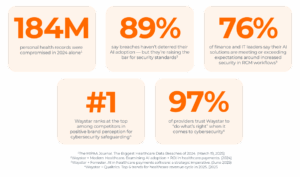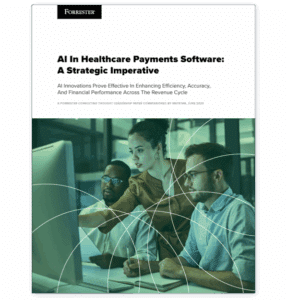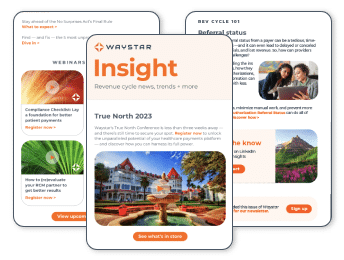As healthcare organizations embrace AI to streamline revenue cycle operations, the question is no longer if you should invest — but how to ensure your investment delivers value.
AI and advanced automation have become strategic imperatives for healthcare organizations, but adoption alone isn’t enough. Healthcare leaders must prioritize solutions that deliver measurable ROI, integrate securely across the end-to-end revenue cycle and continuously improve.
To realize the full power of your AI-powered software investment, recent reports outline five strategies to maximize the value of your AI-powered RCM platform now and in the future.
AI SOFTWARE FOR HEALTHCARE
1. Prioritize deep AI + revenue cycle expertise

With the AI market becoming increasingly saturated, healthcare leaders are doubling down on solutions developed by seasoned vendors with deep RCM expertise. The most effective implementations come from vendors who understand the nuances of payer workflows, healthcare policies, and operational change.
Choose to work with RCM software vendors who have a strong record in AI innovation and results, which typically leads to stronger integration and faster time-to-value.
To address these needs, Waystar launched a comprehensive set of AI capabilities that leverage purpose-built AI and generative AI to elevate productivity and precision for healthcare organizations. AltitudeAI™ works across the entire revenue cycle, empowering organizations of all types and sizes to achieve powerful results — like yielding positive ROI and getting accurate payments, faster.
AI SOFTWARE FOR HEALTHCARE
2. Elevate trust with a relentless focus on data security

After the largest cybersecurity breach in U.S. healthcare history in 2024, most healthcare leaders remain committed to AI adoption — but with heightened demands for compliance, transparency, and data protection.
Security is not optional. Look for vendors who are rigorous in their aim to safeguard patient data.
AI SOFTWARE FOR HEALTHCARE
3. Harness innovation — and apply it with purpose

AI is delivering real results across the revenue cycle — but only when used with clear intent. Leading organizations are going beyond experimentation to deploy AI, generative AI, and advanced automation in targeted, high-impact areas.
To realize the full value of AI in RCM, healthcare leaders must clearly define their use cases — including which revenue cycle tasks AI will support, the expected benefits, and the mechanisms for oversight.
AI SOFTWARE FOR HEALTHCARE
4. Enhance data integrity with end-to-end platforms

Point solutions can be a liability. Fragmented systems introduce risk, increase denials, and force revenue cycle teams into reactive cycles. That’s why more leaders are embracing a full-platform approach that consolidates vendors and centralizes data.
Seek out a consolidated platform to unify your data, simplify compliance, improve forecasting, decrease denials, and increase operational clarity.
AI SOFTWARE FOR HEALTHCARE
5. Optimize for measurable results across the revenue cycle
Today, AI can’t be judged by promises — it must deliver. ROI is the top criteria leaders consider when evaluating RCM software, and healthcare organizations embracing AI at scale are seeing measurable gains.

In other words: AI works — but only when it’s tied to measurable revenue cycle performance goals.
Get all the details about where AI is delivering the most impact and what’s needed to turn promise into measurable performance in a study conducted by Forrester Consulting on behalf of Waystar.
From ROI to efficiency: Invest in AI-powered RCM software + maximize value
AI is no longer a buzzword in healthcare — it’s a business imperative. To unlock its full potential, healthcare organizations must prioritize proven partners, deploy with purpose, and measure for meaningful ROI.
Waystar AltitudeAITM is helping providers reduce costs, recover revenue, and simplify operations — not someday, but now. Let us show you how our AI can help you simplify healthcare payments and address your unique needs within one platform that integrates with most EHR and PM systems — and get results.



